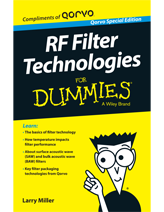Ten RF Filter Technology Facts You Need to Know
January 22, 2016

It's been said that most assumptions have outlived their uselessness, but I assume a few things nonetheless. First, I assume you have an interest in the wireless industry and filter technologies. If so, this article will be of interest for you! Next, I assume you're a design engineer, manager, salesperson, customer, supplier, investor, or just someone who needs to know more about filter technologies. As such, here are ten important things you probably should know about RF filter technologies.
- Filters remove unwanted frequency components from a signal while preserving desired frequency components.
- The quality factor (Q factor) is one of the main determiners of filter loss. Lower Q leads to higher loss and rounding of the filter corners. This rounding of the corners can be problematic for narrowband modulations.
- The wider the bandwidth and the greater the required selectivity, the more the insertion loss parameter must be sacrificed. The design engineer must balance these characteristics in order to eliminate increasing the power amplifier (PA) output and potential increased current and matching components.
- The most common filter configuration for mobile devices is an acoustic filter — surface acoustic wave (SAW) and bulk acoustic wave (BAW).
- The most common acoustic filter architecture is a ladder configuration, where multiple resonators are connected in a series and shunt arrangement.
- A duplexer with a high isolation between the transmit and receive frequencies is optimal when trying to achieve high sensitivity in a user's wireless system design.
- SAW devices work best at lower frequencies below 1.5 GHz, while BAW technology works best for filter designs above 1.5 GHz.
- In today's mobile environment, the amount of bands required in one device is staggering — and the trend will only increase. Supporting all these bands causes coexistence issues requiring filters to reject bands, such as public safety, global navigation satellite system (GNSS), Wi-Fi, and others. Filters have an important role in allowing coexistence between bands.
- Spectrum allocation for new frequencies requires filters to have much tighter temperature drift. Qorvo's LowDrift™ and NoDrift™ filter technology best addresses these temperature drift requirements. NoDrift technologies can produce an essentially zero parts per million per degree Celsius (ppm/°C) characteristic.
- Advanced packaging technologies developed by Qorvo, such as CuFlip (pronounced "copper flip") and wafer level packaging (WLP), enable high performance and high levels of integration. These characteristics will be increasingly necessary as the band count and complexity level of radio frequency (RF) front ends continue to increase.
To learn more about RF filter technology, download our e-book, RF Filter Technologies For Dummies®. You'll learn the basics of RF filters, temperature drift, acoustic filters and filter packaging technologies.
– Excerpted with permission from John Wiley & Sons, Inc., from RF Filter Technologies For Dummies.
Have another topic that you would like Qorvo experts to cover? Email your suggestions to the Qorvo Blog team and it could be featured in an upcoming post. Please include your contact information in the body of the email.
